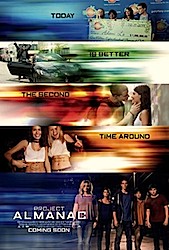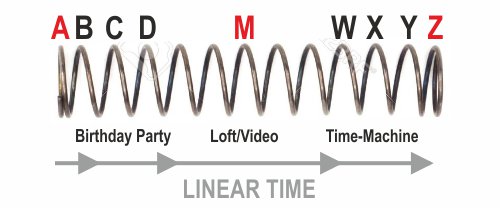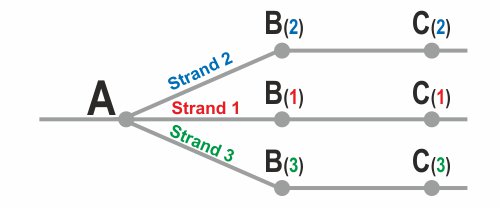

Project Almanac (SPOILERS)
Cert: 12A / 106 mins / Dir. Dean Israelite / Trailer

This review contains spoilers. Big, massive, reality-rending spoilers which defy all logic and causality. Just like Project Almanac itself, in fact. For words about the film without giving everything away, you should read this review, instead. Thanks.
Now, I know I shouldn't hold up Project Almanac to the standard set by Looper, as that's a bit like comparing The Expendables to Apocalypse Now, but I'm pretty much going to. A good time-travel movie doesn't have to convince the audience exactly how the machine/device/portal operates, only that it does. And rest assured, Project Almanac makes little-to-no attempt to unravel the operational parameters of a backpack-sized device which incorporates sixteen car batteries and a cannibalised Xbox. The characters say it works, the films shows that it works, that's good enough for me.
However, when a time-travel movie is going to centre itself around causality-loops (and that is largely the point of them, to be fair), then the screenplay does have to set out and abide by The Rules™. These can, and do, vary from film to film, which is fine as the whole thing's fiction anyway. But if the story's own mechanics are bent - or worse, ignored, then the film becomes nonsense on an internal level, because you can't make a good movie out of poor writing.
Now, the best example of how to do this properly would be Back To The Future. The story (across all three movies) is solid, and despite diagrams of alternate timelines, never tries to out-clever itself. The aforementioned Looper has a few minor hiccups, but manages to ride over them fairly smoothly, while About Time on the other hand, is pretty much broken from the get-go, but is such a good film away from the time-travel that it matters less, somehow.
And now we have Project Almanac, the well-meaning ADHD stepchild of the temporal-transit family. As I mentioned in my spoiler-free review, the film has some very interesting ideas, but is hampered by needlessly annoying cinematography and one other thing: the fact that the causality is utterly broken.
So, there are two main ways of illustrating the effects of time-travel, relating to events being altered in "the past". Springs and branches. Please, bear with me…
Spring Theory…

…in which time, as we understand it, can be represented as a spring or coil. A single unbroken stream of events which begins at A and works its way inexorably to Z. In the spring, occurrences taking place at B, C and D will affect the status quo and influence the situations and occurrences at W, X and Y, on some large or small level. As the "present" progresses through the coiled spring, all events are influenced either by their state at Point A, or the interference of other events at later points.
Since time is effectively a single strand moving in a single direction, it is immutable. The illusions of chance and free will mask the fact that events were always destined to occur the way they did due to the chain-reaction of cause and effect. If we were to travel back to an earlier point in the spring and observe events remotely, we'd see that the choices made by individuals and the events we think of as 'random' would repeat themselves, as there are no external factors in the timeline to change either their inputs, present-circumstances, or their resulting outputs.
But if we could go back to an earlier point in the spring and change an event (in our perception), we'd create a loop whereby we were always going to interfere with the past-point, and so it would be altered even when we passed through it the first time as our younger selves. This is where we run the risk of creating a massive paradox, of course, as we'd still have to decide at a future point that there was an event which required changing, despite us already having fixed it in our own past.
Using the diagram above, if a traveller were to jump from point X to point C, irrespective of whether any physical or causal changes were made, the traveller will always have made that jump. When the jumper lived through point C the first time, they may not have seen themselves or noticed their own future-influence, but they were there nonetheless. The real quandary is that if the traveller does see their future self, it can act as a 'guarantee' that they'll live to the point in the future where they can jump back and be spotted. For example, if you saw your ten-years-older self today with your limbs, eyes and faculties as they are now, you could safely take up a hobby as a knife-thrower's assistant, base-jumper or crocodile wrestler. Under the spring-theory, this would make absolute sense.
As paradoxical as this scenario sounds, this is exactly what happens at the start of Project Almanac. The central character, David, discovers a video-recording of his 7th birthday party, recorded by his father, in which his 17yr old self briefly appears in a mirror. The reflection is picked up by the camera but un-noticed by everyone else in the room, so no-one was alerted to the anomaly at the time. At this part of the film, David and his group of friends have yet to build their time-machine, so using the diagram above, this puts David at point M, watching a recording of point C in which his future-self from point X is present. Whatever happens to David between point M and point X, he now knows he's going to build and use a time-machine, because in a single-strand reality, he always will. If David decides he wants to change the events at point C, he'll need to jump back to point B and intercept his first series of alterations to the timeline. Then again, if that was going to happen then it did/will-do anyway.
"What will be, has been" so to speak, and a coiled-spring timeline can only be altered in our perception, not in chronological reality...
Branch Theory…

…in which time, as we understand it is represented as a fractal, or the branch of a tree. The branch only grows in one direction, forward, but splits at junctions creating co-existent realities as decisions are made, or more pertinently in the case of Project Almanac, as changes are made to the previously-existing course of events. This theory of time-travel is far more prevalent in cinema (Back To The Future being the best illustrated example).
This representation of time is infinitely changeable, and alterations to the past-timeline do not occur until a traveller jumps back and interferes in the chain of events, causing a branch-off in the continuity. It's also worth mentioning that in Project Almanac, the time-travellers inhabit their own separate bodies, which is to say that they don't leap into earlier versions of themselves (see About Time), but are their own discrete entities that can see each other.
If David's friend, Quinn jumps from point C(1) to A through Strand 1, in order to make an alteration to the timeline, he'll then set a new course of events in motion, Strand 2. Strand 1 still occurred, in order for him to be present again at point A, but Strand 2 will now exist as well. Whether the jumper from C(1) will 'return' to point C(1) or to point C(2) is pure conjecture, but C(2) is the one that most time-travel movies are built upon.
This new stream of events will continue in parallel to the old one, with the jumper having a memory of the old timeline (branch 1), the memory of jumping and making the change, and (presumably) the lived-through memory of the new timestream upon returning to the altered 'present'. If Quinn then decides he doesn't like the result of his alteration and wants to undo his change, he'll have to leap back from C(2) to A and prevent his Stream 1 self from creating Stream 2. Although this will, in theory, create a Stream 3 which will be hopefully so close to Stream 1 that the difference is negligible.
(for the record, it's not clear how the newly created realities and cross-strand travellers interact in Project Almanac. At one point the group return to their 'present' after visiting the Lollapalooza festival only to find they have no knowledge of the timeline in the newly created strand, and they still remember the 'old' sequence of events. Yet within the same act, the group discuss travelling further back to prevent their visit to the festival, and claim they'll then lose the memory of being there - despite having already visited it in one reality. It's inconsistent, but it's not my main point of contention with the film. Again, see my amnesia theory in the About Time review.)
Now again, as paradoxical as this sounds, this is exactly what happens in the second act of Project Almanac. On their first (their very first) time-jump one day into the past, Quinn takes the group to the house (indeed, bedroom) of his sleeping-self. He pulls out a marker and says "I always wanted to try this since I saw it in Looper*1", before drawing a smiley-face on the neck of his sleeping past-self counterpart. As he draws the face it also simultaneously appears, line by line, on his own neck, illustrating that he's split the timeline and has created a strand whereby he has Sharpie-ink on him for the day leading up to the first time-jump.
The group jumped from the stream without the neck-graffiti and into the one with it. The only way to undo this would be for a traveller to come back from later in the newly-created stream and somehow prevent the doodling. Quinn would then not have the face on his neck, but because of the interference would still be inhabiting a third timestream. The first and second strands still exist on the tree, but are unreachable since any attempt to cross the branches only creates more…
Still with me?
Good. Now, problem with the time-travel mechanism in Project Almanac is that it uses (as exemplified) both of these theories. Either of them can be used within a story (it's fiction, after all), but they're counter-intuitive to the point where you can't have both.
Scenario 1: If the story is based on Spring-theory, then David can see his future-self in the video of his past-self, because that chain of events was always going to happen, and his watching of the video is part of that chain. But if that's the case then traveller-Quinn would have had the smiley-face drawn on his neck before he's shown drawing it on sleeper-Quinn, because it was always going to be drawn on there several hours before the jump.
Scenario 2: If the story is based on Branch-theory, then traveller-Quinn can draw on his sleeping younger-self and have the doodle show up on his own neck as he creates an alternate timestream. But if that's the case then David won't see his future-self in the video of his past-party because his present-self hasn't yet reached the part of the time-stream where he can create the fork. The video he watches in the loft will be of Stream 1, as David's still in Stream 1 and hasn't reached the point where he can create Stream 2 (and the Stream 1 party-tape will always be the Stream 1 party-tape; David's appearance in the mirror will be in the Stream 2+ tape).
Scenario 3: The writers of Project Almanac didn't spend long enough working out the mechanics of their own narrative device. It's not a clever "paradox", it's a flat-out inconsistency.
Oh, and while I'm on, when David jumps back to the 'before the world ends' sequence again to stop himself being a stupid klutz with the girl he fancies, where does first-David go?. The incidents with Quinn's bedroom and Jessie in the alleyway show us that two of the same person will exist in the same timeline, so where was klutz-David when smooth-David was on the pull? What, did he send himself off to get some candy-floss, or something?
But like I said, I still rather enjoyed the film.
I must have done, because I don't normally spend anywhere near this amount of time writing about the movies I don't like…

If you're as fixated on the mechanics of time-travel as I am? Probably.

It's a rental, really.

Can't really say, but I hope not.

WELL I THINK I'VE ALREADY ANSWERED THAT ONE, DON'T YOU?

I won't, oddly.

There ain't.

David's dad, Ben is played by Gary Weeks, who had a small role in Anchorman 2, as did Han Solo himself, Harrison Ford.

*1 Amazingly, writers Andrew Deutschman and Jason Pagan have chosen to homage Looper by referencing the one aspect of the film which clearly doesn't work, making changes to the timeline which would alter the future to the point where the changer wouldn't then be present to execute them. It's almost as if they didn't understand Looper, or just didn't care.
DISCLAIMERS:
• ^^^ That's dry, British humour, and most likely sarcasm or facetiousness.
• Yen's blog contains harsh language and even harsher notions of propriety. Reader discretion is advised.
• This is a personal blog. The views and opinions expressed here represent my own thoughts (at the time of writing) and not those of the people, institutions or organisations that I may or may not be related with unless stated explicitly.

No comments:
Post a Comment